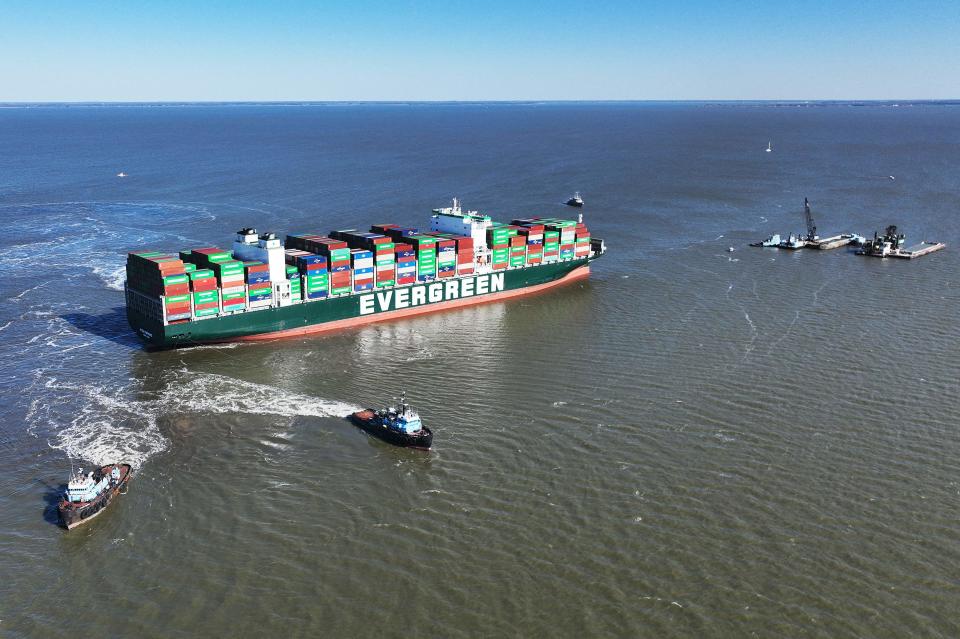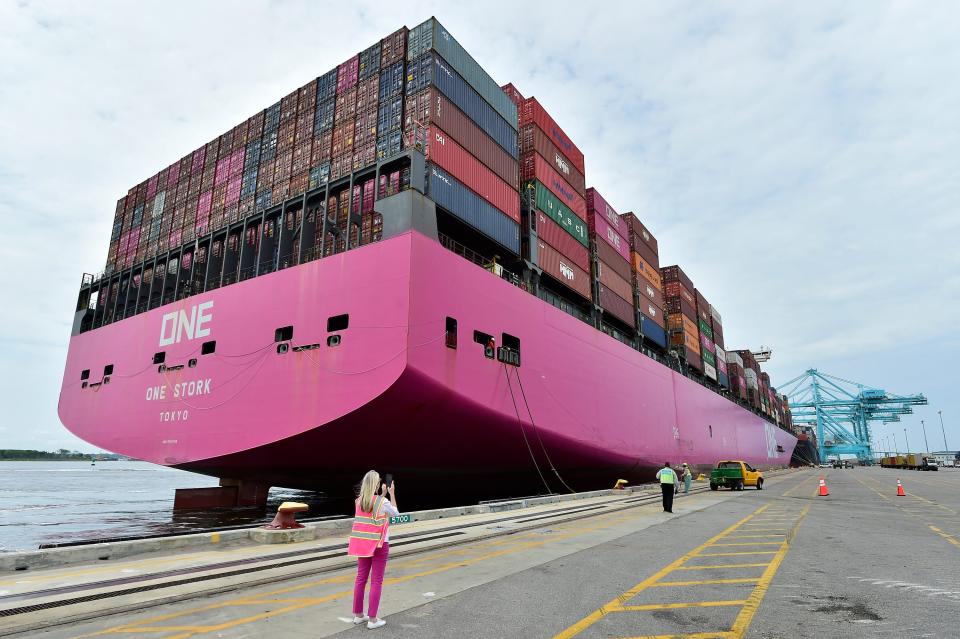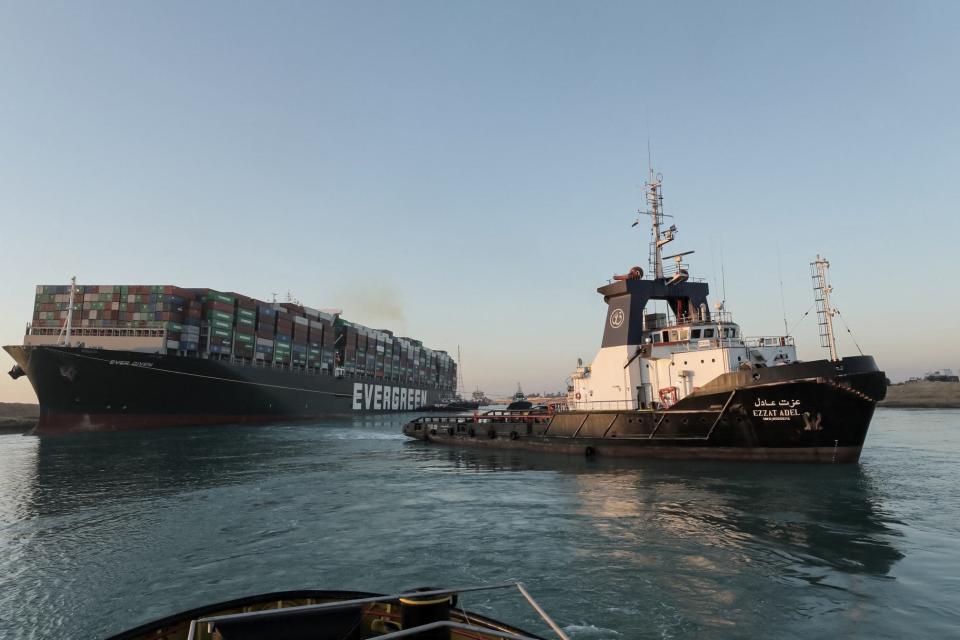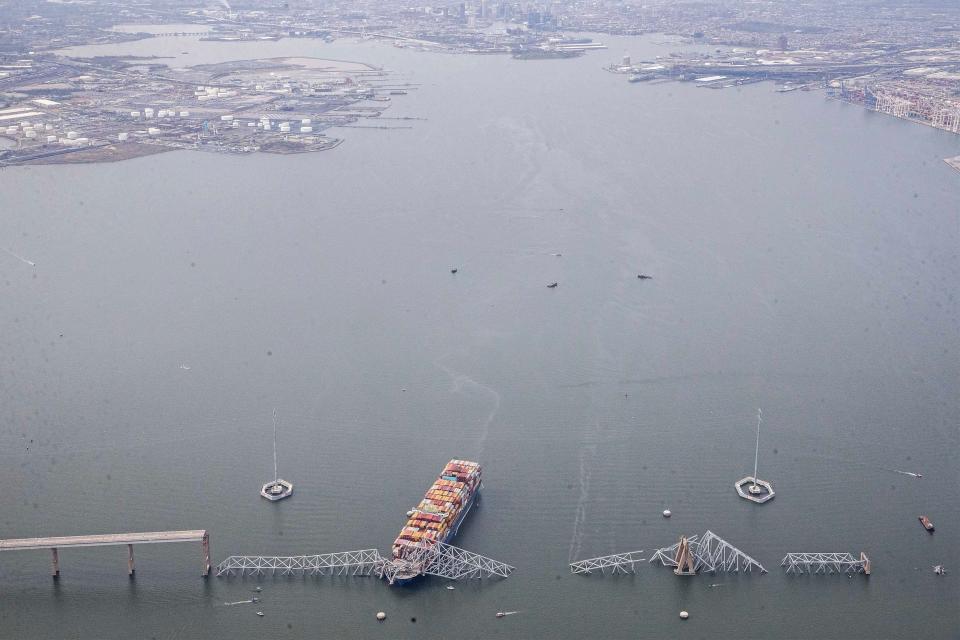Tugboats left before ship reached Baltimore bridge. They might have saved it.
As investigators work to determine what caused the hulking Dali container ship to topple Baltimore’s Francis Scott Key bridge in a matter of seconds on Tuesday, maritime experts around the country are pointing to what could have stopped it.
Tugboats.
These small but mighty vessels tow and push ever-larger ships through channels and help them when their propulsion systems – or lack thereof – cannot. They are standard equipment in ports worldwide and are especially useful to help ships with docking and undocking.
On Tuesday, a pair of tugboats operated by McAllister Towing and Transportation did just that, helping the Dali unmoor itself from the main terminal at the Port of Baltimore and orient the ship toward the open waters.
But they broke away before the massive ship navigated under the bridge, as is common practice. Minutes later, the Dali appeared to lose power and propulsion, sending the craft adrift and directly into one of the bridge’s support columns. The steel-truss bridge immediately collapsed into the frigid Patapsco River.
The accident is igniting debate over the proliferation of “megaships” that fuel today’s commercial transportation industry and whether port protocols have ramped up to safely accommodate them. Although the Dali is average-sized compared to many of these behemoths, the devastation it caused in Baltimore was formidable.
Live updates: Two bodies in Baltimore bridge collapse recovered; search for 4 others ends
Had the tugboats accompanied the ship all the way under the bridge, some experts said, they might have been able to stop, slow, or steer it away from danger.
Such a scenario should be standard operating procedure in all ports, said Capt. Ashok Pandey, a master mariner and associate professor of maritime business at the Massachusetts Maritime Academy. But he said the industry’s reliance on tugs has waned over the years as technological advancements gave many ships the ability to maneuver through channels independently.
Technology is great, Pandey said, until it fails.
“We went wrong by simply equipping ships with bow and stern thrusters that we use in lieu of tugs to maneuver in and out of the ports,” Pandey said. “When we are getting into ports like Baltimore, within a few miles of the bridge, that's too important an asset that we must think of protecting it by all means possible. And we can do that. We can easily do that.”

It may be rare for a ship to lose power at such a high-stakes moment, but it clearly does happen, and he said tugboats could have averted catastrophe.
Implementing such a practice would require a significant investment for U.S. ports, which either own and operate their own tugboats or contract out for tug services. Those costs are then rolled into the ports’ fees charged to shipping companies who use their facilities.
“There are a finite number of tugs, and 99.9% of the time there are no issues,” said Sal Mercogliano, a former merchant mariner and current maritime historian at Campbell University who also hosts a YouTube show called “What’s Going On With Shipping?”
“If the port required tug escorts in and out, then they would not be able to help other ships dock, and undock,” Mercogliano said. “It would need more tugs, and the question becomes, how much will this cost, and will it be passed on to the consumer?”
Because ports compete with each other for shipping business, he said, it’s unlikely that one port would mandate tug escorts unless all of the ports did it for fear of losing lucrative contracts. Shipping companies want the most efficient and cost-effective deal and will simply move to the next port if confronted with higher costs or longer waits.
Mercogliano said he’s not even sure tugboats would have been able to stop the Dali from hitting the bridge. When its power appeared to fail, the ship was going about 8 knots – roughly 9 mph – with a weight of over 100,000 tons.
“It would be like a Prius trying to move a Mack truck on the highway,” he said.
Realities of the container ship arms race
The Dali isn’t even big compared to other container ships hauling goods from port to port these days.
Over the past several decades, newly constructed ships have ballooned to gigantic proportions with load-carrying capacities that used to require five or six ships. The largest container vessel in the 1980s had a maximum capacity of 4,300 20-foot containers – otherwise referred to as TEUs, or 20-foot equivalent units – the standard unit of measurement for cargo capacity.

Today’s largest ship, the MSC Irina, has a capacity of 24,346 TEUs.
The Dali, by comparison, has a capacity of just under 10,000 TEUs, making it the typical “meat and potatoes of container ships,” said Kevin Calnan, assistant professor of marine transportation at California State University Maritime Academy.
Like most container ships, Calnan said, the Dali has one engine and one propeller. Its emergency diesel generator, standard in all such vessels, has enough power to keep key systems going – but not enough to restart the engine or provide propulsion.
In a video posted to social media, lights on the Dali shut off, then turned back on, then shut off again before the ship struck the bridge. Experts said that was likely the generator as it powered up the lights but not the engine.
It would have taken a second engine on board to fully power the ship and restore propulsion at that point. But Calnan said nobody in the commercial shipping industry is advocating for two engines because of their size and cost.

“Cargo is money, and companies want to maximize the amount of space they want to put cargo in, so to build a ship with a whole other engine would be taking up the space of, like, 150 containers on that ship,” he said. “Unfortunately, there’s not too much movement to require these ships to have two engines.”
Calnan, who has worked and sailed on numerous ships during his career, is among the experts who believe tugboats “definitely” could have stopped the Dali from hitting the bridge. He said he has been in similar situations where the power went out and “having tugs there basically saved the day.”
It may take a disaster for industry and ports to change
The bigger the boats and the more sophisticated the technology, the fewer the crew members on board. The Dali's crew is 22-strong.
In his 26 years sailing on commercial ships, Capt. Mike Campbell said he witnessed that shift to smaller crews as automation and electronics made it possible to do more with less when it came to docking, navigating and maintaining the engines.
“I had captains who would turn the radar off in the middle of the day because they didn't want to wear it out, and you'd just go off visual cues, take readings off lighthouses. Now everything is chips and boards,” he said. “And people are more dependent or reliant on it because they are more reliable.”
Campbell, now a professor at the Massachusetts Maritime Academy and master of the training ship Kennedy, said he’s also seen captains push to meet tight schedules, recalling a time when several other chemical carriers owned by competitors sailed out of the Port of Philadelphia into bad weather. His ship stayed put for three days, and arrived in Houston, safely, a day behind schedule. The other ships, he said, all had to sail to shipyards for repairs caused by the storm.
“I was fortunate that the people I sailed under, my mentors, they never worried about the schedule. It was always about the safe operation of the ship,” he said. “You don't want to push things.”
Mariners are always worried about their schedules now, Pandey said.
The shipping industry has become so highly competitive, with companies all vying for a slice of the business, that crews are more likely to leave port without containers than wait on a late shipment and risk falling behind. Ships typically go from port to port, spending anywhere from six to eight hours in each before moving on to the next.

He called it a race to nowhere in which everyone – from the ports to the shipping companies – is playing along.
U.S. ports have spent billions of dollars over the years adapting to the new reality – upgrading their facilities and dredging their channels deep enough to accommodate these massive ships. Some experts warn they could get even bigger in the future, possibly doubling in cargo capacity at some point.
Amid the race to compete for the revenue and jobs brought by these ever-larger ships, port authorities seem to have forgotten about protecting their critical infrastructure, according to Pandley, the former master mariner. He said Tuesday’s accident might be the wake-up call they need to do some real soul-searching.
USA TODAY reached out to the American Association of Port Authorities to ask its thoughts on requiring tug escorts or any other measures to avert the kind of disaster that happened in Baltimore, but a spokesman said nobody was immediately available to take those questions.
Unfortunately, experts said, it often takes a tragedy to improve an industry.
That’s what happened after the 1989 Exxon-Valdez oil spill in Alaska when the U.S. government required double-hull construction for all newly built oil tank ships and all oil tank barges in American waters. California passed a law in the aftermath of that disaster, requiring all oil tankers to have tug escorts in its ports and harbors.
“We have a saying that the laws are written in blood,” said Roland Rexha, international secretary-treasurer of the Marine Engineers’ Beneficial Association, the oldest maritime union in the United States.
“Knowing what we know now, could we have had tugs accompany the ship to the bridge? Sure. But what were the issues that caused the vessel to lose power in the first place?” he said. “There will be an investigation, and we’re hopeful that the lessons learned will lead to an active change in how things are operated.”
This article originally appeared on USA TODAY: Could tugboats have prevented Baltimore Key bridge disaster?
